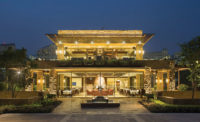
Located in Bloomfield, NJ, the Sacred Heart Church was constructed from mottled brick and terra-cotta with brownstone trimmings. It was completed over a period of two years, and on October 19, 1890, it became the permanent home for the parish. The building was then renovated in the 1950s and again in June of 2002. As a result of this most recent renovation, the 13,500-square-foot building, which seats 700, has a new, but traditional look in natural stone.
The goal of this project was to "create a classical, Romanesque structure to generate an Old World appearance, but modernizing it at the same time," explained project manager Sargon Adamo of Christopher Alexander Associates of Glen Rock, NJ, a firm specializing in restoration. As a key element of the project, Rosa Anatolia marble with a brushed finish was used as the primary stone throughout the church. Initially, polished marble was going to be used to replace the original terrazzo flooring, but the brushed finish was ultimately selected for practical reasons, Adamo explained. The brushed finish was considered to be less slippery, less formal and offer better wear and tear than the polished finish. Not only was the use of the Rosa Anatolia appropriate, but the stone was also much richer in color than any of the others, according to Adamo.
The stone was quarried in Turkey by Ozer International, LCC, which has a U.S. office in Harrison, NJ. Unfortunately, none of the parties involved in the construction of the project were able to visit the quarry -- because of the foreign difficulties the U.S. was having at the time -- but they were able to rely on Ozer to choose stones that were consistent in color. Adamo explained that these stones were specifically quarried for this project, as opposed to choosing the individual stones from stock material.
The Rosa Anatolia marblewas cut into 18- x 18-inch tiles with a thickness of 3?of an inch. Additionally 3?inch-thick filled/polished red travertine pieces were used as accent pieces in the floor design as well as stairs and the wall bases. The prefabricated steps were assembled from 83 pieces cut from a template. "The stairs alternated stone types of red marble and red travertine for visual effect and definition of each stair for safety purposes," explained the architect, Art Sikula of Arthur Sikula Associates of New York, NY.
One of the most unique characteristics of the new internal design was the addition of two symbolic red and white tumbled travertine mosaics. A main focal point is the mosaic fret, which is an eight-pointed star that lies underneath the baptismal font. The eight points represent Christ's Eighth Day of Creation, according to Sikula. A second mosaic was in the shape of a star, counting 12 points. "The altar, surrounded by a 12-pointed star, symbolizes the 12 foundation stones in Jerusalem and the 12 Apostles," the architect said.
Sikula was also pleased with was the installation of the tabernacle, completed by Speros Paximos of Ionion Marble of Astoria, NY. "The tabernacle was fabricated with a thickness of 3?inch pieces, laid together to look like a solid block of stone. It was beautifully executed," said Sikula.
During the construction process, there were a few difficulties to overcome. "The structure of the church basically stayed the same," said Adamo. "Mostly cosmetic improvements were done." Because of the age of the building, "avoiding the existing structure cracks and mirror fractures and making the new foundation fracture resistant was a challenge," he said.
The age of the building also caused some difficulties for general contractor, Malanga Construction of Clifton, NJ. "The existing floor had to be braced in order to hold the marble as well as removing major supports," owner Nicholas Malanga said. The general contractor also had to overcome the natural imperfections of the stone as well. Although the imperfections of a stone characterize its individuality, Sacred Heart's committee wanted the stones to be as "perfect" as possible, and Malanga wanted to accommodate his client.
According to Paximos, with eight men working on the installation and completing 500 square feet a day, the installation of the marble took a few months.
Natural stone was also brought in for the exterior of the building, as flamed New Pink and Balmoral Red granite were specified. The New Pink granite was specified as 30- x 30- x 1 1?inch panels, while the Balmoral Red was used for the entrance steps, each measuring 12 x 36 x 1 1?inches.
Overall, the outcome of the project has been positive. With only a few minor finishing touches to be done, the project was completed by August of 2002. At the grand opening and dedication on March 15, 2003, both Adamo and Malanga said, "Everyone was astonished with the results."

End BoxSacred Heart Church -- Bloomfield, NJ
Architect: Arthur J. Sikula Associates, New York, NYStone Supplier/Quarrier: Ozer International, LLC, Harrison, NJ
General Contractor: Malanga Construction, Clifton, NJ
Project Manager: Christopher Alexander Associates, Glen Rock, NJ
Stone Installer: Ionion Marble, Astoria, Queens, NY



